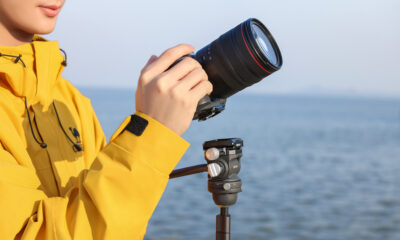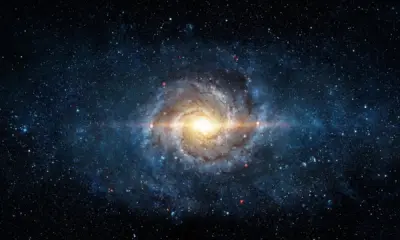Science
Discover North America’s 10 Best Stargazing Destinations

Stargazing enthusiasts seeking dark skies can find refuge in a selection of remarkable locations across North America. In an age where light pollution obscures celestial wonders for over 80% of the global population, many are left yearning for a glimpse of the Milky Way. The good news is that there are still places where darkness prevails, and astrotourism thrives.
Astronomers use the Bortle scale to classify sky darkness, ranging from 1 for the darkest skies to 9 for heavily light-polluted areas. A Bortle 1 sky allows the Milky Way to shine so brightly that it can cast shadows, while Bortle 7 and above nearly erases it from view. For optimal stargazing, visits should be planned around the new moon, ideally in the week before or after, to minimize moonlight interference.
Top Stargazing Locations
Here are ten of the best stargazing spots in North America, all boasting Bortle ratings of 1 to 2:
Natural Bridges National Monument, Utah
This site is not only a National Monument but also an International Dark Sky Park. Known for its stunning sandstone arches—Kachina, Sipapu, and Owachomo—Natural Bridges became the first designated Dark Sky Park in 2007. The park is a haven for astrophotographers, especially during summer when the Milky Way can be seen behind Owachomo. Visitors can camp on a first-come, first-served basis.
Cherry Springs State Park, Pennsylvania
As one of the few stargazing locations on the U.S. East Coast, Cherry Springs State Park offers Bortle 2 night skies from its elevated plateau in northern Pennsylvania. The park features a dedicated astronomy observation field and hosts the annual Black Forest Star Party each September, attracting both seasoned astronomers and casual stargazers.
Jasper National Park, Alberta
Famed among amateur astronomers, Jasper National Park is designated as a Dark-Sky Preserve and hosts the Jasper Dark Sky Festival every October. Despite the tragic wildfires in 2024 that affected its landscape, the park remains a prime location for stargazing, with its Bortle 2 night skies making it ideal for celestial observations.
Chaco Culture National Historical Park, New Mexico
This UNESCO World Heritage Site features Bortle 1-2 night skies and offers a glimpse into the ancestral Puebloans’ astronomical alignments. The park’s observatory provides public telescope nights, enhancing the experience for visitors interested in astronomy and astrotourism.
Black Mesa State Park, Oklahoma
Located in extreme northwest Oklahoma, Black Mesa State Park is known for its Bortle 1 night skies. The park, surrounded by a nature reserve, serves as a great spot for both birdwatching and stargazing, particularly during events like the Perseid meteor shower and the annual Okie-Tex Star Party in September.
Voyageurs National Park, Minnesota
Famed for its water reflections, Voyageurs National Park offers Bortle 2 night skies. The park is a popular destination for aurora viewing, especially from August to March, and hosts the Voyageurs Star Party, featuring ranger-led telescope programs.
Big Bend National Park, Texas
As part of the Greater Big Bend International Dark Sky Reserve, this park possesses some of the darkest skies in the U.S. With a Bortle 1 rating, it is a prime location for stargazing and is complemented by the nearby McDonald Observatory.
Grasslands National Park, Saskatchewan
This park covers 281 square miles (729 square kilometers) of prairie and badlands, providing nearly perfect conditions for stargazing with a Bortle 1 rating. Since becoming a Dark Sky Preserve in 2009, it has hosted a dark sky festival each May.
Crater Lake National Park, Oregon
Elevated at 6,178 feet (1,883 meters), Crater Lake offers Bortle 1 night skies. Its unique geography reduces atmospheric distortion, making it an excellent site for stargazing. Visitors can enjoy stunning reflections of the Milky Way in the lake’s waters, although forest fire smoke can affect visibility during late summer.
Waterton-Glacier International Peace Park, Montana and Alberta
This UNESCO Biosphere Reserve combines Glacier National Park in Montana with Waterton Lakes National Park in Alberta. Known for its diverse landscapes, the park provides a serene setting for stargazing and features astronomy programs, including the Logan Pass Star Parties during the summer months.
These locations not only offer breathtaking views of the cosmos but also allow visitors to experience the profound beauty of nature under a truly dark sky. Whether you are an experienced astronomer or a casual observer, North America’s diverse landscapes provide ample opportunity for unforgettable stargazing experiences.
-

 Technology4 months ago
Technology4 months agoDiscover the Top 10 Calorie Counting Apps of 2025
-

 Health2 months ago
Health2 months agoBella Hadid Shares Health Update After Treatment for Lyme Disease
-

 Health3 months ago
Health3 months agoErin Bates Shares Recovery Update Following Sepsis Complications
-

 Technology3 weeks ago
Technology3 weeks agoDiscover 2025’s Top GPUs for Exceptional 4K Gaming Performance
-

 Technology2 months ago
Technology2 months agoElectric Moto Influencer Surronster Arrested in Tijuana
-

 Technology4 months ago
Technology4 months agoDiscover How to Reverse Image Search Using ChatGPT Effortlessly
-

 Technology4 months ago
Technology4 months agoMeta Initiates $60B AI Data Center Expansion, Starting in Ohio
-

 Technology4 months ago
Technology4 months agoRecovering a Suspended TikTok Account: A Step-by-Step Guide
-

 Health4 months ago
Health4 months agoTested: Rab Firewall Mountain Jacket Survives Harsh Conditions
-

 Lifestyle4 months ago
Lifestyle4 months agoBelton Family Reunites After Daughter Survives Hill Country Floods
-

 Technology3 months ago
Technology3 months agoUncovering the Top Five Most Challenging Motorcycles to Ride
-

 Technology4 weeks ago
Technology4 weeks agoDiscover the Best Wireless Earbuds for Every Lifestyle





















